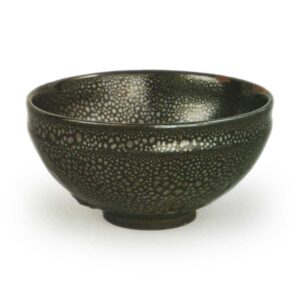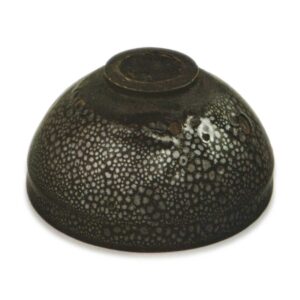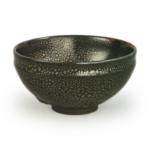

Important Cultural Property
Ryuko-in Temple
Height: 4.6cm
Mouth diameter: 9.0cm
Outer diameter of stand: 3.5cm
Height: 0.4cm
The size of tenmoku teacups is generally fixed. If you look at the data of the pieces collected in this volume, you will see that the diameter is approximately 11 to 13 cm and the height is 6 to 7 cm, as if they were stamped with a seal of approval, and that the size is constant. The size of the vase is about the same as the size of a Ryuuko-in, which can be held in both hands and still have a little extra volume.
However, the Ryuuko-in and the Fujita Museum’s Aburidokitenmoku are ridiculously small, breaking this standard. The dimensions of these two pieces, with a height of just over 4 cm and a diameter of 9 cm, are obvious, but to the eye accustomed to normal sized tenmoku, they seem terribly small. It is a truly lovely piece. However, the small size does not mean that it is poor. The petite shape of the bowl shines like a gem and shows the majesty of a king.
There are some clay markings on the base and the side of the base, but the entire surface has been covered with iron sand, so the color and quality of the clay is not clear. However, since it is recognized as being from the same kiln, it is thought to be fine white clay. The white of the clay can be seen peeking out slightly around the corner of the base or the corner of the bowl. This is the kind of work that was done to make the clay look black, in accordance with the tenmoku of the authentic Jiany kilns.
The shape is beautifully finished on the potter’s wheel, and the height of the base is also neatly carved. As can be seen from the fact that the diameter is twice as large as the height, the bowl has a rather flat shape. However, as usual, the mouth is made to look deep. The glaze is rather thinly applied all over the surface, and the silvery oil droplets are beautifully formed on the slightly sepia-tinged black ground. The glaze is identical to that of the white glazed wares at the Fujita Museum of Art. The oil droplets are almost circular in shape, but the glaze has been boiled by the fire around the outer edge of the glaze, and large bubbles can be seen in several places. There are some fine bubbles just below the outer rim and around the end of the stepped band where the curving to the hem begins. This is probably related to the particularly thin glaze layer in that area. On the other hand, very large oil droplets appear near the prospective flat bottom, especially there, where only a few grains have sunk.
This may be due to the fire or the glaze layer.
This piece was handed down from ancient times at Ryukoin temple in Daitokuji, and is accompanied by a beautiful mother-of-pearl inlay stand. There is an inscription in gold on the inside of the stand, but it is not clear what it means.








